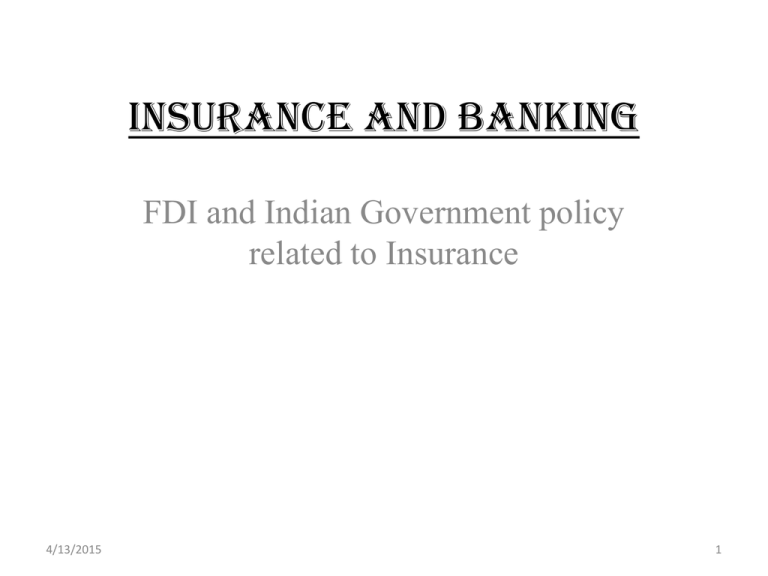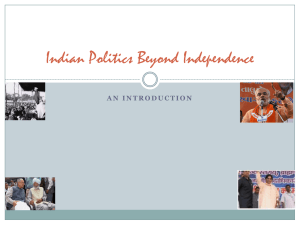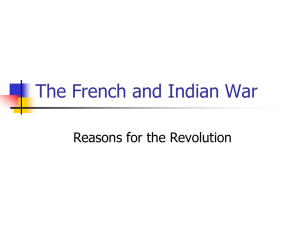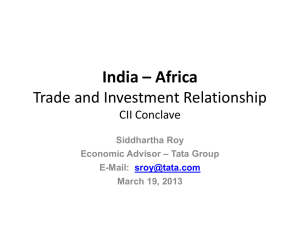FDI & INSURANCE
advertisement

INSURANCE AND BANKING FDI and Indian Government policy related to Insurance 4/13/2015 1 OBJECTIVE OF THE PAPER India is the third most attractive foreign direct investment destination in the world. The Indian insurance companies offer a comprehensive range of insurance plans. Due to the growing demand for insurance, more and more insurance companies are now emerging in the Indian insurance sector. The present paper aims to study the pattern of FDI in Insurance Sector and the Government regulation in the said sector. The paper studies current trend in Insurance sector, the challenges and the prospects ahead 4/13/2015 2 INSURANCE REGULATION IN INDIA • Insurance in India started without any regulations in the nineteenth century • After the independence, the Life Insurance Company was nationalized in 1956, and then the general insurance business was nationalized in 1972 • Only in 1999 private insurance companies were allowed back into the business of insurance with a maximum of 26 per cent of foreign holding (World Bank Economic Review 2000). 4/13/2015 3 Contd. • Insurance in India used to be tightly regulated and monopolized by state-run insurers. • The Insurance Regulatory and Development Authority (IRDA) Act of 1999 was passed • The insurance business was opened on two fronts • Firstly, domestic private-sector companies were permitted to enter both life and non-life insurance business 4/13/2015 4 Regulation contd…… • Secondly, foreign Companies were allowed to participate, albeit with a cap on shareholding at 26% • Since its inception IRDA has been taking steps to promote insurance sector and also protect interest of people • A number of reforms have been introduced by IRDA regarding regulation of agents,deciding about premium, marketing strategies etc 4/13/2015 5 Milestones of insurance regulations in the 20th Century • 1912 First piece of insurance regulation promulgated – Indian Life Insurance Company Act, 1912 • 1928 Promulgation of the Indian Insurance Companies Act • 1938 Insurance Act introduced, the first comprehensive legislation to regulate insurance business in India • 1956 Nationalisation of life insurance business in India • 1972 Nationalisation of general insurance business in India • 1993 Setting-up of the Malhotra Committee 4/13/2015 6 • 1994 Recommendations of Malhotra Committee released • 1995 Setting-up of Mukherjee Committee • 1996 Setting-up of an (interim) Insurance Regulatory Authority (IRA) • 1997 Mukherjee Committee Report submitted but not made public • 1997 The Government gives greater autonomy to LIC, GIC and its subsidiaries with regard to the restructuring of boards and flexibility in investment norms aimed at channellizing funds to the infrastructure sector 4/13/2015 7 • 1998 The cabinet decides to allow 40% foreign equity in private insurance companies – 26% to foreign companies and 14% to non-resident &investors (FIIs) • 1999 The Standing Committee headed by Murali Deora decides that foreign equity in private insurance should be limited to 26% • The IRA Act was renamed as the Insurance Regulatory and Development Authority (IRDA) Act • 1999 Cabinet clears IRDA Act • 2000 President gives assent to the IRDA Act 4/13/2015 8 INSURANCE IN INDIA • Insurance in India remains at an early stage of development • It can be postulated that by 2014 the penetration of life insurance in India will increase to 4.4% and that of non-life insurance to 0.9% • Indian insurance market is the 19th largest globally and ranks 5th in Asia • The public sector Insurance companies have continued to dominate the insurance market • Enjoying over 90 per cent of the market share. In fact, the LIC, which is the only public sector life insurer, enjoys over 98 per cent of the market share in Life insurance 4/13/2015 9 Type of Business NOS OF PUBLIC SECTOR COMPANIES NOS OF PRIVATE SECTOR COMPANIES TOTAL Life insurance 01 12 13 General insurance 06 08 14 Reinsurance 01 - 01 Total 08 20 28 4/13/2015 10 Market Share of Life and non-Life Insurance Sectors INSURANCE SECTOR LIFE INSURANCE 2001-2002 PRIVATE SECTOR PUBLIC SECTOR GENERAL INSURANCE 4/13/2015 PRIVATE SECTOR PUBLIC SECTOR 2002-2003 0.54 1.99 99.46 98.01 3.68 8.64 91.36 96.32 11 Contd.. • The Indian insurance market it accounts for only 2.5% of premiums in Asia, it has the potential to become one of the biggest insurance markets in the region • India is among the most promising emerging insurance markets in the world 4/13/2015 12 FDI IN INSURANCE 4/13/2015 • India is the third most attractive foreign direct investment destination in the world • The present figure of FDI in insurance sector is 26% • The proposal to hike that figure to 49% • India received approximately US$25 billion worth of FDI in 2007-2008; that number increased to US$27 billion in 2008-2009 • While no target has been fixed for the financial year 2009-10, so far FDI inflows for April and May 2009 have surpassed US$4.4 billion 13 The SWOT Analysis Of Indian Economy For Insurance Sector • The present increase in FDI would benefit Indian economy • There are vast opportunities in Indian market both for domestic and foreign players • The insurance sector in India is slated to grow to beyond Seventy Billion Dollars by the fiscal year 2011 • Despite the formidable success achieved by LIC, the government has noted that only by bringing in more FDI can they create an environment for Investment in insurance by the average middle class Indian and otherwise 4/13/2015 14 SWOT ANALYSIS STRENGHTS WEAKNESS • A range of new products had been launched to cater to different segments of the market, while traditional agents were supplemented by other channels including the Internet and bank branches • These developments were instrumental in propelling business growth, in real terms, of 19% in life premiums and 11.1% in non-life premiums between 1999 and 2003. • 4/13/2015 • • India is among the lowest-spending nations in Asia in respect of purchasing insurance (China, which spent USD 36.3 per capita on insurance products & Indian spent USD 16.4) Even after the liberalization of the insurance sector, the public sector Insurance companies have continued to dominate the insurance market In the long run, other forms of non-price competition like aggressive advertisement wars are likelyTo lead to increasing costs, eventually harming the interests of the consumers. 15 SWot contd… STRENGHTS WEAKNESS • India has a large population with an increase in its per capita income • India’s middle income is rapidly increasing emerging as a profitable market • A key challenge for India’s non-life insurance sector will be to reform the existing tariff structure. From a pricing perspective, the Indian non-life segment is still heavily regulated • Reinsurance is only provided by GIC • While the insurance business is highly concentrated in India, the share of foreign companies is low 4/13/2015 16 OPPORTUNITIES THREATS • India’s improving economic fundamentals will support faster growth in per capita income in the coming years, which will translate into stronger demand for insurance products • Strong growth can be sustained for 30–40 years before the market reaches saturation • Between 1985 and 2003, economic losses in India due to natural catastrophes averaged around USD 1.2 billion or 0.4% of GDP every year • Floods were the main peril, accounting for 40% ofcumulative losses over the period, followed by storms (35%) and earthquakes (20%) 4/13/2015 17 OPPORTUNITIES THREATS • there is plenty of room for growth in personal accident, health and other liability classes • Rising household income and risk awareness will be the key catalysts to spurring more demand for these lines of business in the future • Health insurance could potentially have an important role in driving insurance market development forward CUMALATIVE CATASTROPHIC LOSES 1985-2003 4/13/2015 18 • the largely underserved rural sector holds great promise for both life and non-life insurers 4/13/2015 • strong growth prospects pose pressure on the industry, and the economy at large, to better manage the exposure to natural perils • Questionable Reputation of the Foreign Partners 19 SUGGESTIONS To begin with, India needs to further liberalize investment regulations on insurers to strike a proper balance between insurance solvency and investment flexibility Furthermore, both the life and non-life insurance sectors would benefit from less invasive regulations In addition, price structures need to reflect product risk. Obsolete regulations on insurance prices will have to be replaced by riskdifferentiated pricing structures There is huge untapped potential, for example, in the largely undeveloped private pension market. At the moment, less than 11% of the working population in India is eligible for participation in any formal old-age retirement scheme. Private insurers will have a key role to play in serving the large number of informal sector workers. 4/13/2015 20 contd…….. Price liberalization will be needed to improve underwriting efficiency and risk management International reinsurance 4/13/2015 21 CONCLUSION On the regulatory side, there are outstanding issues concerning solvency regulations, further liberalizing of investment rules, caps on foreign equity shareholdings5 as well as the enforcement of price tariffs in the non-life insurance sector The proliferation of bancassurance is rapidly changing the way insurance products are distributed in India. This will also have strong implications on the process of financial convergence and capital market development in India Health insurance is still underdeveloped in India but offers huge potential, as there will be increasing needs to purchase private health cover to supplement public programmes 4/13/2015 22 CONCLUSION…. Likewise, the deficiencies in current pension schemes should offer significant opportunities to private providers With the majority of the population still residing in rural areas, the development of rural insurance will be critical in driving overall insurance market development over the longer term 4/13/2015 23 THANK YOU 4/13/2015 24











